- Home
- Barry Unsworth
Crete Page 3
Crete Read online
Page 3
CHAPTER TWO
OLD is NEW in CHANIA
Chania is the best place to start when you first come to Crete. It is well placed for seeing the west of the island, which is the region least frequented by visitors, since the coast lacks beaches large enough for tourist development. In recompense you get a sense of remoteness and timelessness here, passing through unspoiled villages, exploring virtually deserted coves, overshadowed constantly by the spectacular presence of the White Mountains, the most imposing range on the island, with a score of peaks that rise to around eight thousand feet, capped with snow from December to June.
The old quarter of the city and the harbor are entirely captivating. In the maze of narrow streets are endless discoveries and surprises, a complex pattern of what has been altered out of all recognition, what has been modified, and what has survived untouched since the Venetians took it from the Genoese in the early years of the thirteenth century, changed its name from Kydonia to La Canea, set about establishing the mansions for their notables that still line the harbor, and constructed the tremendous walls that made the city a bulwark in defense of a maritime empire that was to endure for close on five centuries. The Venetians were great wall builders. You see their work all over the island, with the Lion of St. Mark carved like a trademark over arches and lintels. The massive walls they built to defend the harbor of Chania still stand, as do many of the mansions, now often ramshackle and partly in ruins, or converted to new uses, apartment houses or banks or hotels. During our time in Chania, we stayed in one such hotel, the Casa Delfino, a beautifully converted former palazzo still preserving its paved courtyard, where we had breakfast, its stone staircases, and elegantly arched windows.
Chania: the Venetian harbor
Standing on the old harbor front on a summer evening, facing toward the open sea, with the sun sinking beyond the barren headlands to the west, you are looking at what the earliest inhabitants of this very ancient city saw, the same tints of bronze and fire red and gold that shift across the sheltered water, the same tremulous and fugitive reflections, the same gathering softness in the sky as the light fades. Crete is a harsh land in some ways, unyielding, but its nighttime skies in summer are marked by this indigo softness.
Colors of things, effects of light, these may defy time, but materials do not. The dome of the Mosque of the Janissaries is concrete now, but it still crouches impressively beside the water, with its cluster of lesser domes, a warm biscuit color in the harbor lights, symbol of Ottoman conquest, looking across at the works of its predecessor and rival for empire, still evident in the narrow arched windows and elegant balconies of the houses that the defeated Venetians left behind them.
In general, it is the Venetians who have left their mark on this city rather than the Turks, but the Janissaries were dreaded in their day. This famous corps, the shock troops of the Ottoman Empire in the days of its supremacy, has no parallel in the annals of military history. It was formed in the fourteenth century from Christian slave children, who were converted to Islam, sworn to celibacy, and trained in blind obedience to their commanders and the ruling sultan. In later times, when the central Ottoman power was weakening, discipline was relaxed, they were allowed to marry and granted the privilege of enrolling their children in the corps—the best fed and best paid in the army. Levies of Christian youths ceased after the end of the seventeenth century. By the beginning of the nineteenth the Janissaries were completely out of control, a law unto themselves, a public nuisance and a danger to their own rulers. By tradition they used to gather around their cooking cauldrons to take counsel; when these cauldrons were overturned, it was a signal of rebellion—they would no longer eat the sultan’s food. The atrocities they committed on the Cretan population—who, as always, resisted the foreign yoke—were notorious, probably worse than anywhere else in the Ottoman-controlled Greek lands. They were finally destroyed in 1826, shelled out of existence by regular troops of the Turkish army under the command of the formidable Ibrahim Pasha, known by the nickname of Kara Jehennem, “Black Hell.”
Their mosque in Chania is used now for exhibitions and displays of various kinds. From here to Angelou Street, the old harbor is lined with restaurants, and just about every one of them has a man posted on the pavement outside to solicit the custom of passersby. Anyone who makes this circuit in the summer months will receive instruction in the inventiveness, the inveterate self-defining faculty, of human beings in general and Cretans in particular. The men outside these restaurants, whether young or old, stout or lean, handsome or homely, are aiming at the same thing: They all want to see you seated at one of their tables scanning the menu. But they have adopted a variety of ploys in accordance with temperament. One will assume an earnest manner, even slightly aloof. He doesn’t want to tell you how good the restaurant is, only that it has been there since 1961—a fact also proclaimed on a huge placard overhead. Forty years, it seems, is a long time for a restaurant to exist, in this city which has existed for millennia. Another will be loud and direct and boisterous, like a barker at a fair. Another will sound a wistful note as you pass: Sooner or later, today or tomorrow, you will succumb, you won’t be able to help yourself. Another waxes confidential, buttonholes you, man to man: Let me tell you something about this place that perhaps you don’t know…. Then there is the action man, who blocks our path, thrusts a menu into our hands.
A Chania street
The Cretans, like their compatriots on the mainland, have a great flair for marketing. They make choosing a restaurant resemble shopping in some vast bazaar. And a sort of bazaar it is, though marked with a curious sameness in the midst of profusion. Cretan restaurant food can be very good and the helpings are generous, but—as opposed to the style of those whose task it is to inveigle you inside—there is a certain lack of variety in the main courses. Bream or mullet grilled or baked, mutton grilled or stewed, these form the traditional choices. Depending on the restaurant, variety can be found in the range of snacks known as mezedes, which are often very good indeed, typically consisting of miniature spiced meatballs and sausages, small triangular-shaped cheese or spinach pies, vine leaves stuffed with rice and pine nuts, tzatziki (chopped cucumber, garlic, and yogurt), little saucers of mashed chickpeas or white haricot beans in lemon juice. Still in the exuberant spirit of the bazaar or treasure house, all these items, however small, will be chalked up separately, as if they were main courses, forming long lists on the big slates standing outside. Go inside and you are likely to find them all on one tray. Some restaurants, by no means all, offer Cretan specialties, done as they really should be done: a fish soup called kakavia flavored with onion and lemon, a dish called horta, which is a judicious mixture of wild greens, some of them bitter and some sweet, gathered fresh from the hillsides, boiled and served cold, with olive oil and vinegar. This may sound simple, but it isn’t. When the flavors are blended as they should be, it is superb.
Another very good reason for starting in Chania is that it is distant from the great Minoan palace sites in the central part of the island, remains of a unique and splendid civilization that reached its high point around 1500 B.C. These must be visited, of course—they are what large numbers of people come to Crete for. But there is a lot to be said for approaching from the edge, beginning with the humbler remains that have been unearthed here. Most people, in Minoan times, after all, did not live in palaces, any more than they do today.
Two Minoan sites are being excavated at present in Chania, close together on Kanevaro Street, in the district known as Kastelli, the high ground overlooking the harbor on the eastern side. This is the oldest part of the town, generally believed to be the site of ancient Kydonia, which is the name the Byzantines knew the city by in early Christian times.
Looking at these bare traces, hardly above the level of the ground but demonstrating an order that could never be thought accidental, bearing the unmistakable touch of human design, one has the usual sense of the muteness, the sadness of ruined habitations. The p
eople who lived here were members of a Bronze Age society more advanced than any that had gone before, and any that were to come after for a thousand years. They belonged to the time called by archaeologists the New Palace period, when Minoan civilization was at its most dynamic, when the palaces of Knossos and Festos were being rebuilt after a cataclysmic earthquake, devastation on a scale that would have put an end to a society less vital. The jewelry the well-to-do among these people wore, the textiles and ceramics they used in their houses, have never been surpassed in quality of workmanship and beauty of design. They were not Greeks and their language was not Greek. We call them Minoans, but what they called themselves we don’t know. The name we use was given to them by Sir Arthur Evans, the great archaeologist, who named the people after their legendary ruler, King Minos. Evans was the first man to carry out extensive excavations in Crete. He and others worked on sites throughout the island in the early years of the last century, uncovering an entire civilization that had lain unsuspected below the earth and rubble for thousands of years. Together with Schliemann’s work on the site of ancient Troy a little earlier, it was one of the greatest enterprises in the history of archaeology.
The buildings whose ruins we peer at through the fence on Kanevaro Street were twice destroyed by fire—perhaps more often, there might have been a long cycle of destruction and rebuilding. The first time known to us was around 1450 B.C., when this part of the town was consumed in a great conflagration mysterious in its origins. Minoan sites throughout the island show traces of violent destruction and the scars of fire dating from this time. Natural disaster or the work of invaders or a combination? This is an argument that still goes on.
Poignant evidence that the fire came without much warning is a jar found on the site, containing a quantity of burned peas. A loom was also found, scorched but still recognizable, bringing to mind the peaceful domestic round of the people who lived here, soon to be engulfed. They came back again, in the course of time, from the places where they had found shelter or taken refuge, returned with that tenacity we still see today in the victims of earthquake or flood, who come back to the places they know and painfully rebuild them, seeking to recover the life they had before, which will never again, of course, be quite the same.
Three centuries later these houses were destroyed by fire once again, probably by Greek tribes from the Balkans equipped with iron weapons. This time there seems to have been no recovery, no return—at least no rebuilding: Any who came back must have lived among the ruins. But the fire, devastating as it must have been, brought with it one unforeseen and startling benefit. On this site, baked by the fire and so accidentally preserved, clay tablets were discovered bearing the written language of the people, what came to be called the Linear A script, pictograms of various plant and animal products. These, in spite of devoted efforts, have not yet been fully understood, but they point to a system of economic administration far in advance of anything else in the world of the Mediterranean at that time.
Then came the further, sensational discovery of tablets of a later date, written in a different script, called Linear B. In the early 1950s, after long efforts by such scholars as Michael Ventris and John Chadwick, this was deciphered and shown to be an early form of Greek, proving the presence here of Mycenaeans from the mainland, who by then had become the dominant power. No other site has been so far discovered containing examples of both scripts. What more lies below this hill of Kastelli can only be conjectured; most of the ancient city of Kydonia has not so far been excavated and is perhaps unlikely to be so now. The streets and houses and shops and office blocks have covered it over.
But these scripts, so accidentally discovered, have a value symbolic as well as historical. In this dark weave of violence and destruction, in which both human agencies and acts of God, as they are called, have played their part, there are lighter threads running through; and among them—perhaps chief among them—is human language, human writing. The desire to communicate is the desire to save, to preserve from destruction. This is a paradox that has always accompanied our story and it finds a vivid example here, in these obscure remains. Our own age is just as barbarous, or more—more, certainly, if the criterion lies in capacity for destruction. One hopes the archaeologist of the future will find evidence, in the ruins of our society, of this same saving desire to understand our fellows.
Kanevaro is an ordinary street, with ordinary activities going on: a few stores, a bar, a workshop, people passing—and a fenced-off area where other people lived their ordinary lives three and a half thousand years ago. Such conjunctions are present everywhere on the island, and in Chania, with its long history of human habitation, they spring out at you at every turn.
Still in Kastelli, not very far from the Minoan remains, there is a ruined monastery. Rising high above the broken arches of the cloister and all the tumbled debris of this ancient place of worship, where Byzantine priests once intoned their liturgies, there is a huge placard with a notice: ROOMS FOR RENT WITH BATHROOM AND SEA VIEW. For a wild moment it seems that some Cretan entrepreneur is offering to let ground space among the venerable vaults of the narthex and the weeded wasteland all around. A sea view there would be, certainly, and rooms enough, though roofless. The bathroom would be more problematic. But drawing nearer, you see that a house has been built inside the shell, a cunning combination of ancient stone and modern bricks and mortar. This is the Monastiraki Pension, lodging of undeniable character. The people of the island were for centuries the poorest of the poor. Now, for some of them, the past has turned to gold under the Midas touch of tourism.
The past snatches at you in the names of the streets and restaurants too, but it is the mythical past now. There is the Talus Bar, named after the bronze giant who was given by Zeus as a present to Europa, to be the guardian of her island of Crete. He was said to be the last survivor of the third race of men, after those of gold and silver, people fashioned in bronze, a ferocious race who destroyed themselves in endless warfare. Talus patrolled the cliffs of Crete and threw huge rocks down at any intruders he saw. He was kept alive by a single vein, closed at the ankle with a bronze pin. In the end he was betrayed by the sorceress Medea, who lulled him with promises of immortality and then pulled out the pin….
Then there is, inevitably, a Minos Street, named after the legendary king of Crete, who had the labyrinth of Knossos constructed as a home for the monstrous Minotaur, unnatural offspring of the union of his queen with a bull. The Minotaur, who, as the name suggests, was half royal prince, half bull, fed on human flesh. From Athens there came an annual tribute of youths and maidens to be sacrificed to him.
Close by is Ikarus Street, named for was the son of the great artificer Daedalus, who built the labyrinth. Father and son were kept imprisoned in this same labyrinth by King Minos. Daedalus made wings for them both out of wax and feathers, and the pair embarked on a daring escape plan. But Ikarus forgot his father’s warning not to fly too near the sun. The wax melted and the young man went plunging down into the sea near the island of Samos.
These myths of Crete are among the most ancient we know and have a special quality that makes them stand out among the complex ramifications of Greek mythology. They have a darkness and splendor about them that is essentially tragic. They are stories that have shaped the imagination of the Western world.
Certainly they have shaped mine, from a very early age. The first book—the first real book—that I can remember possessing was called Tales from Olympus, a collection of Greek myths with beautiful color plates, or so I thought then, to illustrate them. I think I was about four at the time and better equipped to admire the pictures than read the text. And, of course, the stories were toned down and poeticized in a way that was thought then to be suitable for children—perhaps the toddlers are tougher now. The treachery and murder so prevalent in Greek myth had been softened. But the characters of the gods and goddesses, and their dealings with humans, came through in all its drama and has been with me ever sinc
e.
On this visit I was particularly aware of the mythological associations. I know I kept exclaiming at the names and launching into long explanations. This must have seemed a bit excessive to Aira, though she didn’t say so. Not much before leaving I had written the final paragraphs of a novel set in Greece on the eve of the Trojan War, and in an effort to understand the world-view of the people of that remote time I had done a lot of background reading: Homer, Greek tragedy, works on prehistoric religion and mythology. So my mind was still full of it. Now, three months later, it’s fading already, as I contemplate a new novel set in a totally different period. It’s similar in a way to studying intensively for an exam. For a while you know everything, you are a walking encyclopedia, you bore friends and strangers alike with unasked-for information. Then, mercifully, it starts to get vaguer. In my time I have been a temporary expert on eighteenth-century sailing ships, medieval drama, the career of Horatio Nelson. To mention but a few.
In any case—because Crete so much sharpens one’s sense of the past, because the associations we form are so swift as to seem unconscious, because of the ruggedness of the island, present-day sights can carry one back in imagination to remotest times. The harbor front at Chania, the light fading, a group of local soccer fans in red-and-white-striped shirts, some wearing a sort of jester’s cap and bells in the same colors, holding aloft a huge red banner bearing the emblem and name of the club. They gather around the banner in a massed group, they take it by the corners and lay it on the ground. They sway their bodies forward and back, chanting a name in devotional unison, raising their arms above their heads, all together, in one concerted movement. The word they are chanting is indistinguishable. The name of a football star or a name of a god? They throw flares that land sizzling on the water. From some soundless smoke bomb in the midst of them, thick swirls rise up, showing ashy pink in the harbor light. The chant continues, and the rhythmic movements of the bodies forward and back, and for a while we are in the presence of a spirit that goes back to a time before Greek and Venetian and Turk, back to the earliest settlements here, to a people primitive and fearful, with jealous divinities to be propitiated.

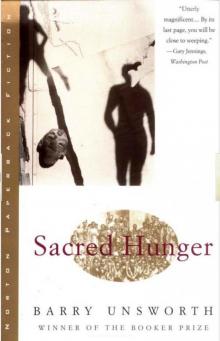 Sacred Hunger
Sacred Hunger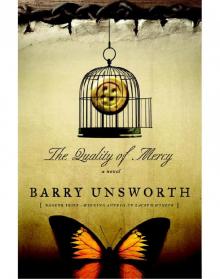 The Quality of Mercy: A Novel
The Quality of Mercy: A Novel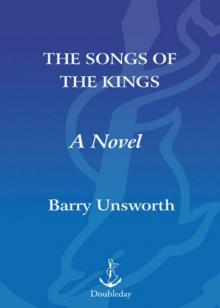 The Songs of the Kings: A Novel
The Songs of the Kings: A Novel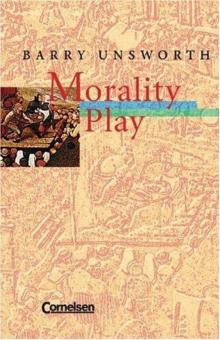 Morality Play. Mit Materialien. (Lernmaterialien)
Morality Play. Mit Materialien. (Lernmaterialien)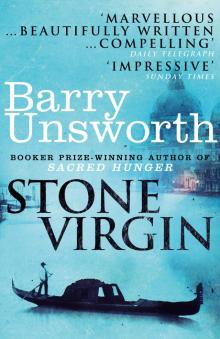 Stone Virgin
Stone Virgin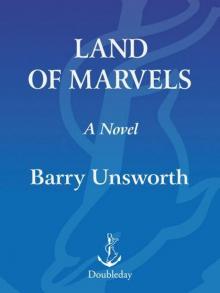 Land of Marvels
Land of Marvels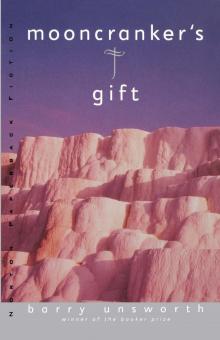 Mooncranker's Gift
Mooncranker's Gift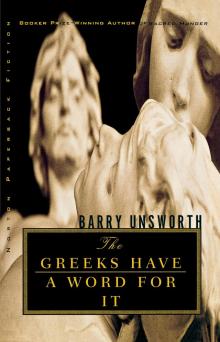 The Greeks Have a Word for It
The Greeks Have a Word for It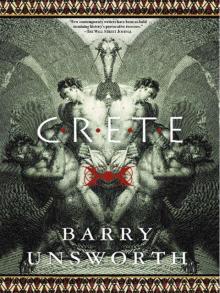 Crete
Crete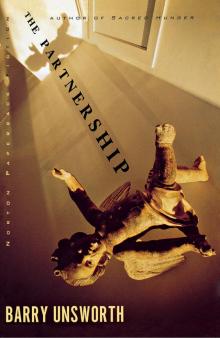 The Partnership
The Partnership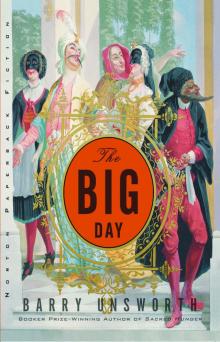 The Big Day
The Big Day The Hide
The Hide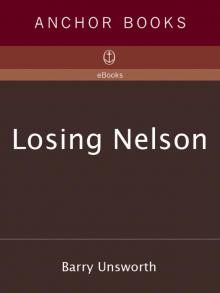 Losing Nelson
Losing Nelson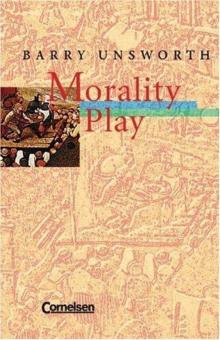 Morality Play
Morality Play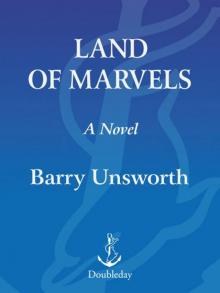 Land of Marvels: A Novel
Land of Marvels: A Novel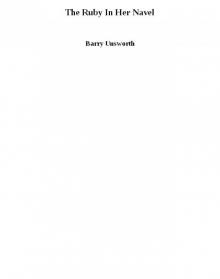 The Ruby In Her Navel
The Ruby In Her Navel